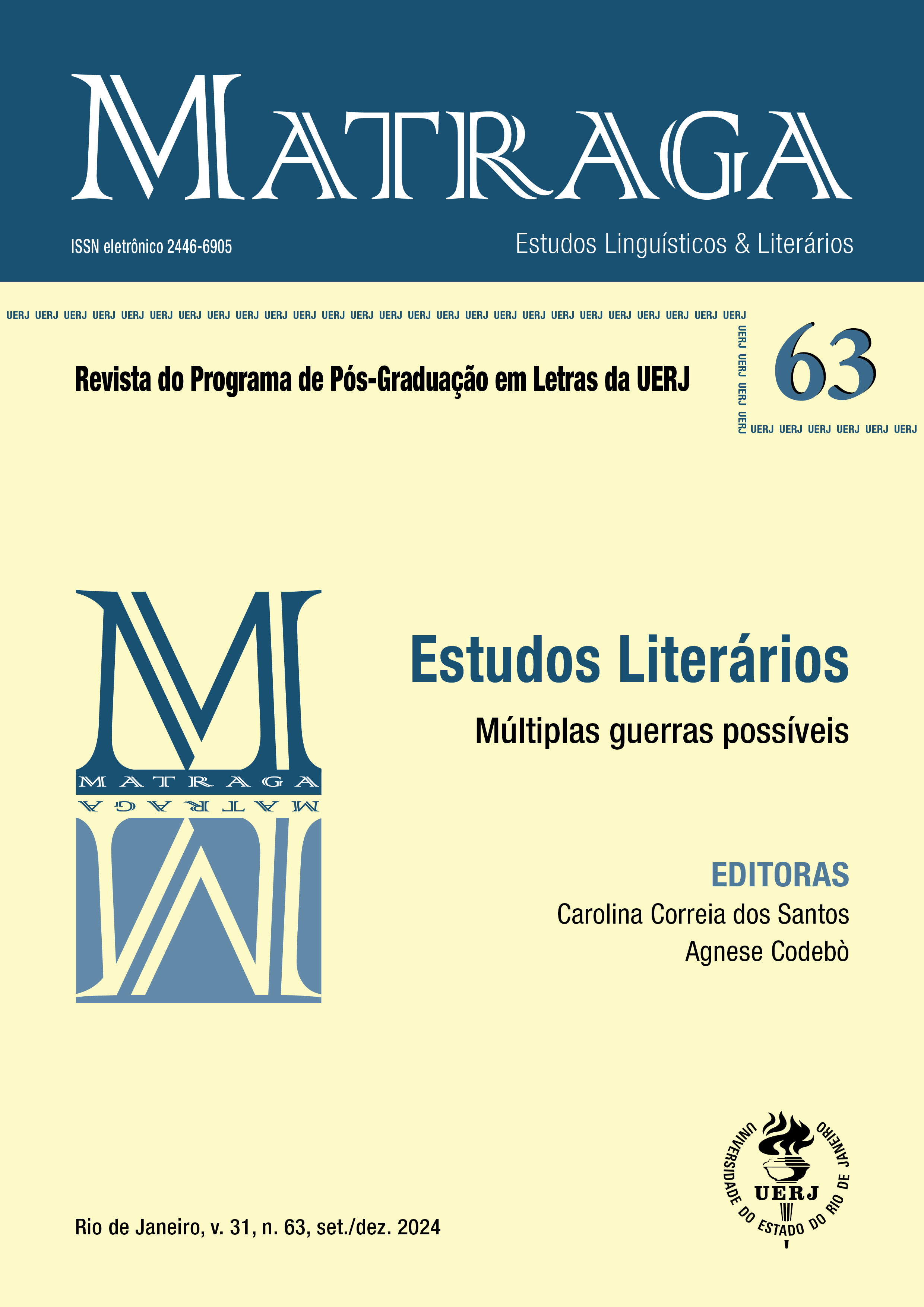Ritual de cura para salvar um menino no ventre: mundos em guerra e a cosmovisão Jarawara em “O espírito aboni das coisas”, de Itamar Vieira Junior
DOI:
https://doi.org/10.12957/matraga.2024.82743Palavras-chave:
Jarawara, Amazônia, Guerras, Itamar Vieira JuniorResumo
No sudoeste do estado do Amazonas, entre os rios Juruá e Purus, habita uma etnia da família linguística Arawá quase totalmente invisibilizada entre a população brasileira: os Jarawara. Em sua cosmovisão, o mundo, organizado entre quatro espaços distintos (terra, água, abaixo da terra e céu), é tecido, de forma abstrata e concreta, pela coexistência de todos os seres: humanos, animais, plantas, árvores, espíritos (inamati) e bichos (yama). Esse mundo animista, na concepção Jarawara, apresenta-se constantemente como perigoso e em guerra, razão pela qual é preciso estabelecer laços com os espíritos (Maizza, 2009; 2012). É justamente da cultura desse povo que Itamar Vieira se alimenta em uma das narrativas que compõe o seu livro Doramar ou a Odisseia. Trata-se do conto “O espírito aboni das coisas”, no qual o leitor acompanha a saga do guerreiro Tokowisa pela floresta e pelas águas amazônicas, a fim de encontrar um objeto (abatosi) que, manipulado pelo xamã da aldeia, seja capaz de salvar sua esposa e seu filho (ainda no ventre) de um feitiço lançado pelo líder espiritual da aldeia rival, contra a qual estão em guerra. Tomando essa narrativa, nosso objetivo neste texto é articular uma análise Ecocrítica do conto, apropriando-nos de aspectos que caracterizam o seu enredo e suas personagens para tecermos correlações entre a cosmovisão Jarawara (as relações em um mundo constantemente perigoso, em guerra) e os modos como o escritor baiano elabora sua ficção.
Downloads
Referências
BERRY, Peter. Beginning theory: an introduction to literary and cultural theory. 3. ed. Manchester: Manches¬ter University Press, 2009.
BOFF, Leonardo. Ecologia: Grito da terra, grito dos pobres. São Paulo: Ática, 1995
BUELL, Lawrence. The Future of Environmental Criticism: environmental crisis and literary imagination. Oxford: Blackwell, 2003.
DURAND, Gilbert. Mito, símbolo e mitodologia. Lisboa: Presença, 1981.
ELIADE, Mircea. Mito e realidade. São Paulo: Perspectiva, 1972.
FLYS JUNQUERA, Carmen. Ecocriticas: literatura y medio ambiente. Madri: Iberoamericana Editorial Ver¬vuert, S. L, 2010.
GARRARD, Greg. Ecocrítica. Brasília: Editora UNB, 2006.
GUATTARI, Félix. As três ecologias. São Paulo: Papirus, 1990.
HARAWAY, Donna. “Anthropocene, Capitalocene, Plantationocene, Chthulucene: Making Kin”. Environ¬mental Humanities, v. 6, n. 1, 2015, p. 159-165. Disponível em: <https://doi.org/10.1215/22011919-3615934>. Acesso em: 14 jan. 2024.
KLEIN, Naomi. This changes everything: capitalism vs. the climate. New York: Simon & Schuster, 2015.
KRENAK, Ailton. Ideias para adiar o fim do mundo. 2. ed. São Paulo: Companhia das Letras, 2020.
KRENAK, Ailton. O futuro ancestral. São Paulo: Companhia das Letras, 2023.
LYNAS, Mark. A espécie divina: como o planeta pode sobreviver à era dos seres humanos. Rio de Janeiro: Alta Books, 2012.
MAIZZA, Fabiana. Cosmografia de um mundo perigoso: espaço e relações de afinidade entre os jarawara da Amazônia. 2009. 313f. Tese (Doutorado em Antropologia) – Universidade de São Paulo, São Paulo, 2009. Disponível em: <https://www.teses.usp.br/teses/disponiveis/8/8134/tde-03022010-143732/pt-br.php>. Aces¬so em: 14 jan. 2024.
MAIZZA, Fabiana. Cosmografia de um mundo perigoso: espaço e relações de afinidade entre os Jarawara da Amazônia. São Paulo: Edusp; Nankin Editorial, 2012.
MENDES, Maria do Carmo. No princípio era a Natureza: percursos da Ecocrítica. Anthropocenica – Revista de Estudos do Antropoceno e Ecocrítica 1, 2020, p. 91-104. Disponível em: <https://repositorium.sdum.umi-nho.pt/handle/1822/72242>. Acesso em: 14 jan. 2024.
MOORE, Jason W. Antropoceno ou Capitaloceno? Natureza, história e a crise do capitalismo. Tradução Antônio Xerxenesky e Fernando Silva e Silva. São Paulo: Elefante, 2022.
QUIJANO, Aníbal. Colonialidad y Modernidad-racionalidad. BONILLA, Hercílio. (Org.). Los conquistados. Bogotá: Tercer Mundo Ediciones, 1992. p. 437-449.
VERNANT, Jean-Pierre; VIDAL-NAQUET, Pierre. Mito e tragédia na Grécia Antiga. São Paulo: Perspecti¬va, 2014.
VIEIRA JUNIOR, Itamar. Doramar ou a odisseia: histórias. São Paulo: Todavia, 2021.
VOGEL, Alan. Dicionário Jarawara-português. Anápolis: Associação Internacional de Linguística SIL – Brasil, 2016.
Downloads
Publicado
Como Citar
Edição
Seção
Licença

Este trabalho está licenciado sob uma licença Creative Commons Attribution-NonCommercial 4.0 International License.
AUTORIZAÇÃO
A Matraga – Revista do Programa de Pós-Graduação em Letras da UERJ está autorizada a publicar o artigo ora submetido, caso seja aceito para publicação online. Fica atestado que a contribuição é original, que não está sendo submetida a outro editor para publicação, e que a presente declaração é a expressão da verdade.
Os trabalhos publicados no espaço virtual da Matraga – Revista do Programa de Pós-Graduação em Letras da UERJ serão automaticamente cedidos, ficando os seus direitos autorais reservados à Matraga. Sua reprodução, total ou parcial, é condicionada à citação dos autores e dos dados da publicação.

A Matraga utiliza uma Licença Creative Commons - Atribuição-NãoComercial 4.0 Internacional.





